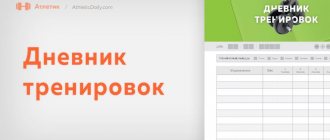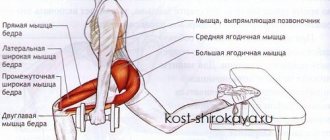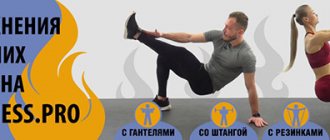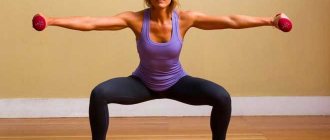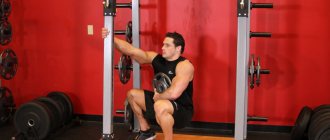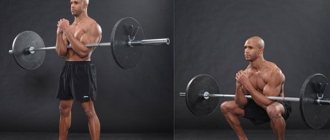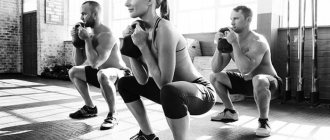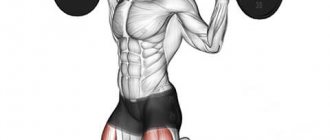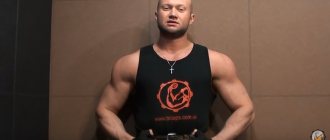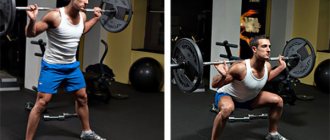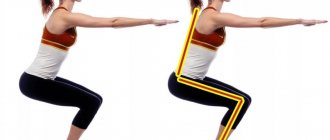Imagine how great it will be if doctors and sports specialists invent an exercise that will solve several problems in one fell swoop. It will work several muscle groups at once, burn fat, improve overall health, and improve heart function. What if such an exercise already exists, and everyone is familiar with it from school? After all, these are ordinary squats.
- Injuries
- The harm of weighted squats
- Harm to joints
- Harm from diseases of the heart and blood vessels
- Harm due to concomitant diseases
What are squats
Squats are designed to strengthen muscles, which is why they are included in most workout programs. This very natural movement for a person, despite all its simplicity, perfectly maintains the muscles of the lower body in tone. To perform the exercise, no special equipment or special physical skills are required: raising and lowering the body is performed by bending the legs at the knees.
There are several types of squats, each of which has its own unique and beneficial properties and affects specific muscle groups. Based on your training goals, you can choose the most suitable option for yourself.
Squats: what they are and how they are used
Squatting is a physical exercise, the essence of which is to lower the body while bending the knee joints. It is key
not only in strength sports, but also for general physical training. There are many variations of this exercise, each better suited for a specific purpose. It can be performed with your own weight, with additional weights in your hands, with a barbell, etc.
This exercise is one of the basic ones in all strength sports, and is also indispensable in fitness and bodybuilding. When performing this exercise, all leg muscles are used.
- gluteal, quadriceps and hamstrings, calves, and other small muscle groups.
The versatility of this exercise is very high - it can be used both to gain muscle mass and to burn fat; to increase endurance, to work out in detail each bundle of leg muscles, depending on the type of squat, to improve the overall tone of the muscles of the lower extremities, to strengthen the spine, to improve the condition of tendons and joints, and also to increase the strength of the legs. Squats can be performed with different foot positions
, which affects the emphasis on one or another group of leg muscles. In addition, you can perform them on one leg, or with a jump, which allows you to very well increase the strength of the lower extremities.
Squats are used to tone and strengthen the lower extremities. They can make your legs stronger and more resilient. This exercise is included in the training process of any athlete, as it is the best for working the lower extremities.
Benefits of squats
Performing squats is not difficult, but the properties of such an exercise clearly have great benefits for physical condition and health:
- Building muscle mass. Thanks to squats, the quadriceps and calf muscle fibers, hamstrings and others are actively worked out. Exercise tends to increase the production of testosterone and growth hormone in the body, thereby stimulating effective muscle building. The benefits of squats with a barbell or dumbbells for the arms are manifested in the activation of the biceps and triceps muscles.
- Fat burning. Actively working out muscles provokes the burning of fat in the body. By building muscle fibers, the body burns calories, thereby getting rid of fat cells. That is why squats have invaluable benefits for girls who want to lose extra pounds.
- Maintaining body mobility. In addition to strengthening the lower body, squats can also maintain mobility throughout the body as a whole. Interesting! Performing the exercise with full amplitude helps develop all the main muscles of the legs, which helps you not feel tired after prolonged physical activity.
- Improved coordination. To this property of squats you can also add the development of body mobility, which, in turn, helps improve strength skills and increase muscle mass. Squats provide the foundation for other calf development exercises: single-leg squats or calf raises.
- Development of physical capabilities. In addition to the benefits for individual areas of the body, squats can significantly improve the physical capabilities of the entire body: for example, after regular training, the distance you run or the length of your jump may noticeably increase. Squats also help improve performance in other sports, be it tennis or gymnastics.
- Preventing injuries. By developing a large number of accessory muscles in the lower region, the risk of injury or damage to muscle fibers is greatly reduced. The beneficial properties of squats contribute to the coordinated work of muscles and joints while maintaining a stable body position. It is only important to follow the correct technique for doing the exercises and follow the recommendations.
- Development of the sphincters of the central part of the body. Another benefit of squats is that they work the core of the body, including the abdominal area. Interesting to know! Research conducted in 2009 showed that the exercise can put more stress on the abdominal muscles than regular crunches. And squats on one leg tend to involve a large muscle mass, with the benefit of working the muscles of the legs and buttocks.
- Improvement of joint condition. Raising your body while performing a squat synchronizes the work of the hip joint, knees and ankles, evenly distributing the load and thereby reducing the risk of damage to them.
- Help the heart. Squats have invaluable benefits for the functioning of the heart. Unlike most strength exercises, squats do not load the heart muscle: on the contrary, they normalize its functioning. They can also serve as an excellent medicine for diseases such as ischemia or cardiac arrhythmia.
For women
- Working out the main muscles. Almost every girl and woman dreams of having a beautiful and toned figure, and squats are a great helper in this matter. The secret is that the properties of such an exercise will be useful in engaging a variety of muscle groups: in addition to the sphincters of the buttocks and legs, it also works the abs and back. Thus, one exercise can replace several at once.
- Improved blood flow. The functioning of blood vessels in the pelvic area is significantly improved. This is why the benefits of squats are so important for women after 40: they will help improve metabolism, tighten the skin in different parts of the body and significantly improve its appearance.
- Ideal figure. Another useful property of squats for girls and women: regular exercises will help you quickly lose extra pounds, tighten your figure and form correct posture. Squats are also a good help in combating the female problem of cellulite.
For men
- Increased blood flow. Active stimulation of blood circulation in the pelvic area improves microcirculation in all major tissues of this area. As a result, the skin becomes more elastic and toned.
- Working out the abdominal and back muscles, forming correct posture.
- Helps the functioning of the cardiovascular system. Squats with your own weight are of great benefit for men: their properties to strengthen the heart and blood vessels help turn exercise into a full-fledged cardio workout.
- Normalization of metabolism. By accelerating metabolism, the body burns fat cells much more actively and gets rid of the harm of accumulated toxins. Active fat burning, in turn, helps to build muscle mass.
Squats also have benefits for men's health, since they protect joints from damage during intense training in the gym.
We recommend reading: Hanging on the horizontal bar: benefits for the spine, which muscles work
Are squats good for your figure or bad for your health?
When creating a training program, it is important to take into account many factors: a person’s physique, lifestyle, nutrition, level of training, as well as the purpose for which it was decided to take up the exercises. Regardless of whether a trainee's goal is to lose weight, improve muscle definition, increase strength or improve coordination, any training program should include a series of basic exercises that lay the foundation for excellent physical fitness, such as push-ups, pull-ups, lunges and squats
The benefits and possible harm of the latter will be discussed in this article.
Squats allow you to train several muscle groups in your legs and back at the same time, improve coordination and, if done correctly, help keep your entire body in good shape, even if you perform squats without weight. For men, they will serve as a good basis for strength exercises with various equipment, while for women, squats will help maintain a slim and attractive figure. Squats are universal - they can be performed by both a beginner athlete and an experienced bodybuilder. They can be practiced without equipment, training only using the weight of your own body, or with various weights - belts, weights, dumbbells or a barbell, which allows you to choose a load that suits each individual individually. If you look at squats from this position, the benefits of them are undoubted and obvious. However, it is worth mentioning the possible harm that this exercise can cause.
In the middle of the last century, research results were published showing that squats were harmful. They were thought to cause damage to the knee joints by stretching the tendons, thereby leading to knee pain. This sensation led to many trainers completely eliminating this exercise from their training programs. However, more recent studies have shown that squats have no more impact on the condition of the knee joints than the daily loads endured by any healthy person. The only thing that needs to be taken into account is that squats are contraindicated for people who have previously injured their knee, or if performing this exercise is associated with a feeling of pain. For everyone else doing squats, the benefits will far outweigh any possible harm. We are not talking about those who perform squats with a barbell - such exercises should only be performed with already trained back and abdominal muscles and only under the supervision of an experienced instructor in the gym, perhaps even with the use of additional equipment, such as bandages for squats. Such exercises should not be done at home under any circumstances.
In short, “proper” squats should be performed after a good warm-up, keeping your back straight, your feet shoulder-width apart, and your heels pressed to the floor. If you have just started playing sports, then squat low enough so that your thighs become parallel to the floor, and no deeper
When performing an exercise, the important thing is not how quickly and how many squats you do, but how correctly you perform them. If you follow these recommendations when doing squats, you will benefit
If you feel discomfort or pain in your back or knees, take a break for a few minutes. If pain continues the next day, consult your doctor. The main thing is to take care of your health, and it will repay you in kind!
Are squats good for children?
Despite the doubts of many parents, squats are a general strengthening exercise that cannot harm the child’s body. It is actively used in physical education classes in schools and sports clubs, be it swimming or basketball.
The properties of squats will be useful in the formation of an even posture, and in significantly strengthening the joint apparatus (especially the lower extremities, ligaments and tendons).
Moreover, the risk of harm to a child’s body from squats is much lower than for an adult. Squats will help in the formation of a strong skeletal apparatus, and will also be an excellent way to splash out accumulated childhood energy.
Squats: what are the benefits for the body?
Squats are a simple exercise that everyone in our country has known since school. Its popularity is quite justified - there is simply no other exercise like this that uses almost all the muscles of the legs. In bodybuilding and fitness, it is used to increase the overall muscle mass of the body. By performing squats with weights using the correct technique, you can ensure that all the muscles of the body are involved, including the upper part. Actively performing this exercise is accompanied by rapid breathing, which improves heart condition.
.
The benefit of squats also lies in the fact that you can strengthen the joints and tendons of the lower extremities
, improve the condition of the lower back. It has a particularly good effect on the development of knee joints. They will become more durable and will be able to withstand heavier loads. They can protect your knees from degenerative processes that occur over time. In addition, they improve posture and strengthen the back, which is also an important factor.
Regular exercise using this exercise can enlarge your buttocks.
, improve their shapes and volumes.
The thighs themselves will become stronger and more toned. The “breeches” area, a problem for girls
, disappears, and the flabbiness and sagging of the buttocks area decreases.
Squats allow you to more actively circulate blood in the legs, thereby speeding up your metabolism
. This factor will be of great importance for those who are trying to lose weight.
The leg muscles are some of the largest in our body. This means that their work requires a large amount of energy, which is obtained by burning excess calories. That is, they help make your legs more beautiful while at the same time getting rid of excess fat. For women they are even more necessary than for men - since they allow you to immediately get rid of a whole range of problems that torment girls.
How to squat correctly
Before you apply all the beneficial properties of squats on yourself, you need to familiarize yourself with the rules for performing the exercises: to prevent possible harm and enhance the benefits of training:
- Movements should be performed smoothly and softly, without sudden jerks. You need to do the exercise thoughtfully and slowly, trying to feel every muscle in the body. If pain occurs, you should stop exercising and give your body time to rest.
- The optimal training option for beginners is 3 sets of 12 reps.
- Deep squats are especially useful for working the calf muscles. To perform them, you need to lower the body as low as possible.
- The knees should always be above the feet; there is no need to bring your legs together or spread them.
- The main weight of the body is transferred to the heels. The feet should be pressed firmly to the floor; you should not lift your feet off the surface or stand on your toes. This is the only way the gluteal muscle and hamstrings will receive maximum load.
- There is a classic diagram of the correct body position for performing squats: you need to stand straight with your feet shoulder-width apart. Move your pelvis back, imagining that there is an invisible chair behind you. A small box or stool will be an excellent helper for self-control. Do smooth squats while inhaling and exhaling deeply.
Types of squats and their benefits
In sports, there are several useful types of squats, each of which has its own unique properties. It is important to familiarize yourself with the features of each option in order to choose the most suitable one for yourself.
Classic squats
This type of exercise is aimed at uniformly working all the muscles of the legs. Regular squats are beneficial for training the quadriceps, hip adductors, glutes and soleus.
Standing straight, you need to place your feet hip-width apart and your arms along your body. After inhaling, move your pelvis back and bend your knees at a right angle. As you exhale, return to the starting position.
Plie
The benefits of plie squats help work the gluteal and quadriceps muscles of the thigh, as well as its inner surface.
The techniques for performing plie squats and classic squats are similar to each other, the only difference is in the starting position: in the plie, with your feet shoulder-width apart, you need to turn your toes outward at a right angle, and place your hands on your belt.
Sumo
Sumo squats are aimed at comprehensively working the muscles of the legs, buttocks and thighs. They develop hip flexibility and improve overall body mobility.
For the sumo position, you need to spread your legs wide apart, with your toes turned outward. Pull your hips back and squat until your knees form a right angle, then tighten your gluteal muscles as much as possible and return to a standing position.
Jump Squats
The benefit of jump squats is to increase the efficiency and intensity of your workout.
Place your feet shoulder-width apart, while inhaling, bend your knees, and as you exhale, jump sharply up. When your feet touch the floor surface, you must immediately perform the next squat.
Wall Squats
When performing wall squats, the quadriceps and gluteus maximus muscles are actively worked, and the exercise is most effective when adding weights. Wall squats also have benefits for the calves and soleus muscles.
Starting position for the exercise:
- Press your back, shoulder blades and buttocks tightly against the wall.
- Place your feet shoulder-width apart and bend your knees slightly.
- Bend your elbows and place them in front of you, one on top of the other.
Performance:
- After inhaling, without lifting your upper body from the wall, you need to sit down so that your shin and thigh form a right angle at the knee.
- Then you need to exhale, while straining your quadriceps, and return to the starting position.
Scissors
When performing the exercise, you can shift the main load to the anterior or posterior muscle groups. It all depends on the width of the legs: if you move your leg further, the main load will fall on the gluteal muscles and the back of the thigh. Bringing your legs closer together helps work your quadriceps.
You need to pick up the barbell and throw it over your shoulders. With your feet shoulder-width apart, you need to take a step forward. It is very important to control your back: it should be in a straight position, with a slight bend in the lower back.
After this, do a squat, bending both legs at the knees. It is also important to ensure that the knee of the leg in front does not extend beyond the foot. The knee of the second leg should touch the floor surface.
As you exhale, you need to take a vertical position.
Squats with a barbell or weights
Squats with a barbell provide benefits not only for beautiful and pumped buttocks. Such squats significantly improve health: their beneficial properties include strengthening joints and tendons, relieving back pain and normalizing heart function. They are able to speed up metabolism and rid the body of the harm of accumulated toxins.
Starting position: feet shoulder-width apart, holding a weight in your hands. Smoothly perform deep squats. It is important to ensure that your knees do not extend beyond your toes. As you exhale, return to the starting position.
We recommend reading: What are the benefits of vinaigrette for the human body?
The benefits of weightless squats are building endurance, burning excess fat, and strengthening the gluteal and thigh muscles.
How to do it correctly
Effectiveness depends on the correct technique:
- During exercises, you must ensure that your thighs in the lower position are parallel to the floor.
- The back should be straight.
- The feet are completely on the floor surface.
By following these simple rules, you can not only achieve good results, but also reduce the occurrence of injuries.
Training should consist of several sets of 10 squats on average. Over time, the figure gradually increases. A large range of movements also gives a good effect.
The most effective options
So, a list of the most effective exercises:
- Classic type. It brings into excellent shape not only the buttocks, but also the legs and thighs. Gives an even load on all types of muscles, from the ankle to the gluteal. Correct technique:
- Initial position – feet shoulder-width apart;
- Inhale – squat to the level of formation between the shins and thighs at an angle of 90°;
- Exhale - return to the starting position.
When performed correctly, the back is always kept straight with the shoulder blades brought together. Do not rise on your toes; your heels should touch the floor. The head is raised, the gaze is directed ahead. No need to study floor patterns.
When rising to the starting position, it is not recommended to fully straighten your knees. It is better to leave them half-bent. Due to this, the load on the knee joints is reduced.
- “Plie” is an element of ballet that has successfully transferred to fitness. Starting position – feet slightly wider than shoulders, toes turned to the sides. Further, the technique is similar to the classical style. This exercise allows you to create a beautiful buttock shape.
- Squat on one leg. Element of the highest degree of efficiency. The result is felt immediately after several performances. If you have just started practicing, you can play it safe and hold on to something with your hand:
- In the starting position, the legs are shoulder-width apart. One leg is raised bent and extended forward.
- Inhale – we begin to squat, straighten the bent leg in front of us.
- Exhale - return to the starting position.
- With narrowly spaced legs. With this exercise, muscle mass in the buttocks area is gained instantly. Its technique is similar to the classic style, but the legs must be placed together or as close to each other as possible.
By doing these exercises correctly and regularly, in just a month you will see amazing results.
Squats for weight loss
Squats are included in most workout programs for maintaining muscle tone and losing weight.
Classic squats are considered to be the most useful and effective in the fight against extra pounds: they actively strengthen the muscles of the body and promote effective fat burning. In the first week of classes, you need to do at least 3 workouts of 15-20 approaches with a break of 8-10 minutes. However, you should not be overzealous with the number of repetitions - excessive efforts can reduce the effectiveness of exercises and harm the body.
In order to calculate how many calories squats burn in the body, you need to multiply your weight by 0.1. The resulting number is the number of calories burned by squats in 1 minute. So, if a person weighs 70 kg, in 1 minute of exercise his body will burn 7 kcal, in 10 minutes - 70 kcal, respectively.
Interesting! Weighted squats significantly speed up calorie burning.
Beginners are recommended to start with 25 squats per set (on average, you need to do three sets per session), gradually increasing the load. During one such workout, the body can burn from 100 to 200 kcal: it all depends on the intensity of the exercises.
Squats for buttocks
Squats are the most useful and effective exercise for building a beautiful buttock shape. This is influenced by several factors: the shape of the pelvic bone, the volume of fat and the condition of the muscles.
If the size of the bones remains unchanged, then the beneficial properties of squats can manifest themselves in reducing body fat and working out muscles. However, you should not expect the first results after a week of training: they can be seen only after a month of active training. It is very important to combine squats with other exercise options for working the gluteal muscles: scissors, bicycle, lunges and planks. Squats also contribute to the formation of beautiful and slender legs and improve the overall health of women.
The greatest benefit for girls who want to build beautiful buttocks is deep squats (sumo): this is the main and indispensable exercise in building a beautiful figure. It is optimal to perform three approaches every 2 - 3 days, combining squats with other exercises.
How many squats to do
Beginners who are just starting to master the technique of squats should do no more than 30 times in 1 - 2 approaches. Start with 10 - 15 repetitions in one approach and increase the load over time. When squats begin to be performed easily and without difficulty, you can connect various weights with weights that allow you to do the same 10 - 15 times per approach.
There is a unique “method of a thousand squats”. Some may think that doing 1 thousand squats in a day is impossible. But this technique implies an even distribution of the load: you need to do only 10 repetitions in one approach throughout the day, increasing this number over time. Soon the body will be able to perform 100, 200, 500, and then 1 thousand squats per day without much difficulty.
Trainers recommend doing squats in the morning, when the muscles are most adapted to work: then the exercise will bring the greatest benefit.
Harm of squats and contraindications
Despite all the beneficial properties, even such a simple exercise can cause serious harm to the body.
- The greatest danger is squats with weights: they put a serious load on the knee joints, which are not always able to withstand it. This often applies to people who prefer strength sports. In order not to cause harm to the tendons and joints of the knee area, it is necessary to warm up the muscles before training, which will significantly reduce the risk of injury.
- Squats are strictly contraindicated for people with knee joint diseases, since exercise can only increase inflammation and provoke immediate destruction of the joint.
- It is not allowed to squat if you have problems with the spine, scoliosis or diseases of the cardiovascular system. In this case, consultation with a doctor is required.
- Another possible harm factor is excess weight, which puts additional pressure on the knee joints. That is why overweight people need to do the exercise especially carefully and prudently. Start with a small number of repetitions to monitor the body's reaction. It is also recommended to use special bandages for knee joints.
Arguments against deep squatting
In many sports it is necessary to assume a position with your legs bent to varying degrees; but it is extremely rare that such a bend is required in which the upper part of the thigh drops below parallel - a deep squat. Although some disciplines (for example, weightlifting) cannot do without a full squat, for most sports it is not necessary.
One of the advantages of using closed kinetic chain exercises is the specificity of the training [1]. Thus, the use of deep squats contradicts one of the basic purposes of using exercises - sports specificity.
Another important factor when choosing squat depth is safety. A review of the scientific literature in this area published by Escamilla [24] shows that the shear force acting on the tibiofemoral joint is small between 0 and 60° of flexion; however, the greater concern is the compressive force on the patellofemoral joint.
High compressive forces can overload the articular cartilage on the inferior surface of the patella, which can lead to chondromalacia and ultimately osteoarthritic changes [23, 25].
In addition to the potential risk of shearing and compressive forces on the cruciate ligament and meniscus of the knee, it has been found that the patellofemoral joint is subject to greater overload [22, 24].
Additionally, Wallace et al [28] found that patellofemoral joint loads were significantly higher in resistance tests; thus, performing a full squat with additional weights may increase the risk of injury. In healthy people, the load on the patellofemoral joint during deep squats is a major risk factor for injury.
Nagura et al [27] suggest that the development of osteoarthritis may be explained by regular deep squatting, which is more common in Eastern cultures (compared to Western populations). The overall evidence on this issue indicates an increased risk of injury when performing regularly in the deep squat position.
The final consideration is the overall suitability of deep squats. Squatting to parallel is sufficient to significantly activate the working muscles, such as the vastus [23, 24, 29].
A comprehensive review by Escamilla [24] noted that quadriceps activation gradually increases as knee flexion reaches 90°, but there is little evidence of increased activation beyond parallel. Peak activation of the hamstrings is observed in the range from 10 to 60° [26, 29]. Finally, according to the work of Escamilla et al. [23] and Iser et al. [26], gastrocnemius muscle activation appears to peak in the range of 60–90°.
Overall, squatting has a number of well-researched benefits, but some studies find risks of deep squatting .
So, let’s summarize – 3 key arguments against deep squats:
- Full squatting appears to be associated with damage to the patellofemoral joint, which may predispose people to osteoarthritic changes in the articular cartilage under the kneecap .
- It is also important to note that according to EMG measurements, peak muscle activation in the quadriceps, hamstrings, and gastrocnemius occurs during the squat to parallel and does not increase beyond this range of motion . This suggests that squatting below parallel does not increase muscle activation.
- If deep squatting is not a common component of training or performance, then it may not improve athletic performance based on the principle of specificity .
Links to mentioned studies:
1. Caterisano A, Moss RF, Pellinger TK, Woodruff K, Lewis VC, Booth W, and Khadra T. The effect of back squat depth on the EMG activity of the 4 superficial hip and thigh muscles. J Strength Cond Res 16:428–432, 2002. 2. Chandler T, Wilson G, and Stone M. The effect of the squat exercise on knee stability. Med Sci Sports Exerc 21:299–303, 1989. 3. Dahlkvist NJ, Mayo P, and Seedhom BB. Forces during squatting and rising from a deep squat. N Engl J Med 11: 69–76, 1982. 4. Escamilla RF. Knee biomechanics of the dynamic squat exercise. Med Sci Sports Exerc 33:127–141, 2001. 5. Ficat RP and Hungerford DS. Disorders of the Patello-Femoral Joint. Baltimore, MD: Williams & Wilkins, 1977. 6. Kanamori A, Woo SL, Ma CB, Zeminski J, Rudy TW, Li G, and Livesay GA. The forces in the anterior cruciate ligament and knee kinematics during a simulated pivot shift test: A human cadaveric study using robotic technology. Arthroscopy 16:633–639, 2000. 7. Klein K. The deep squat exercise as used in weight training for athletes and its effects on the ligaments of the knee. J Assoc Phys Ment Rehabil 15:6–11, 1961. 8. Klein K. The knee and the ligaments. J Bone Joint Surg 44-A: 1191–1193, 1962. 9. Li G, Rudy TW, Sakane M, Kanamori A, Ma CB, and Woo SL. The importance of quadriceps and hamstring muscle loading on knee kinematics and in-situ forces in the ACL. J Biomech 32: 395–400, 1999. 10. Li G, Zayontz S, Most E, DeFrate LE, Suggs JF, and Rubash HE. In situ forces of the anterior and posterior cruciate ligaments in high knee flexion: An in vitro investigation. J Orthop Res 22: 293–297, 2004. 11. Markolf KL, Slauterbeck JL, Armstrong KL, Shapiro MM, and Finerman GA. Effects of combined knee loadings on posterior cruciate ligament force generation. J Orthop Res 14: 633–638, 1996. 12. Meyers E. Effect of selected exercise variables on ligament stability and flexibility of the knee. Res Q 42: 411–422, 1971. 13. Nagura T, Dyrby CO, Alexander EJ, and Andriacchi TP. Mechanical loads at the knee joint during deep flexion. J Orthop Res 20: 881–886, 2002. 14. Nisell R and Ekholm J. Joint loading during the parallel squat in powerlifting and force analysis of in vivo bilateral quadriceps tendon rupture. Scand J Sports Sci 8:63–70, 1986. 15. Panariello R, Backus S, and Parker J. The effect of the squat exercise on anteriorposterior knee translation in professional football players. Am J Sports Med 22:768–773, 1994. 16. Sakane M, Fox RJ, Woo SL, Livesay GA, Li G, and Fu FH. In situ forces in the anterior cruciate ligament and its bundles in response to anterior tibial loads. J Orthop Res 15:285–293, 1997. 17. Schoenfeld BJ. Squatting kinematics and kinetics and their application to exercise performance. J Strength Cond Res 24:3497–3506, 2010. 18. Steiner M, Grana W, Chilag K, and Schelberg-Karnes E. The effect of exercise on anterior-posterior knee laxity. Am J Sports Med 14: 24–29, 1986. 19. Underwood J. The knee is not for bending. Sports Illustrated 16: 50, 1962. 20. Weiss L, Fry A, Wood L, Relyea G, and Melton C. Comparative effects of deep versus shallow squat and leg-press training on vertical jumping ability and related factors. J Strength Cond Res 14:241–247, 2000. 21. Cordova ML. Considerations in lower extremity closed kinetic chain exercise: A clinical perspective. Athl Ther Today 6:46–50, 2001. 22. Dahlkvist NJ, Mayo P, and Seedhom BB. Forces during squatting and risingfrom a deep squat. Eng Med 11: 69–76, 1982. 23. Escamilla RF, Fleisig GS, Zheng N, Barrentine SW, Wilk KE, and Andrews JR. Biomechanics of the knee during closed kinetic chain and open kinetic chain exercises. Med Sci Sports Exerc 30:556–569, 1998. 24. Escamilla RF. Knee biomechanics of the dynamic squat exercise. Med Sci Sports Exerc 33:127–141, 2001. 25. Hefzy MS, Kelly BP, and Cooke DV. Kinematics of the knee joint in deep flexion: A radiographic assessment. Med Eng Phys 20: 302–307, 1998. 26. Isear JA, Erickson JC, and Worrell TW. EMG analysis of the lower extremity muscle recruitment patterns during an unloaded squat. Med Sci Sports Exerc 29: 532–539, 1997. 27. Nagura T, Dyrby CO, Alexander EJ, and Andriacchi TP. Mechanical loads at the knee joint during deep flexion. J Orthop Res 20:881–886. 28. Wallace DA, Salem GJ, Salinas R, and Powers CM. Patellofemoral joint kinetics while squatting with and without an external load. J Orthop Sports Phys Ther 32: 141–148, 2002. 29. Wretenberg P, Feng F, and Lindberg U. Joint moments of strength and quadriceps muscle activity during squatting exercise. Scand J Med Sci Sports 3: 244–250, 1993. Strength and Conditioning Journal | www.nsca-lift.org 3
Source: lookgreatnaked.com
Translation for Zozhnik: Alexey Rebuplicommando
